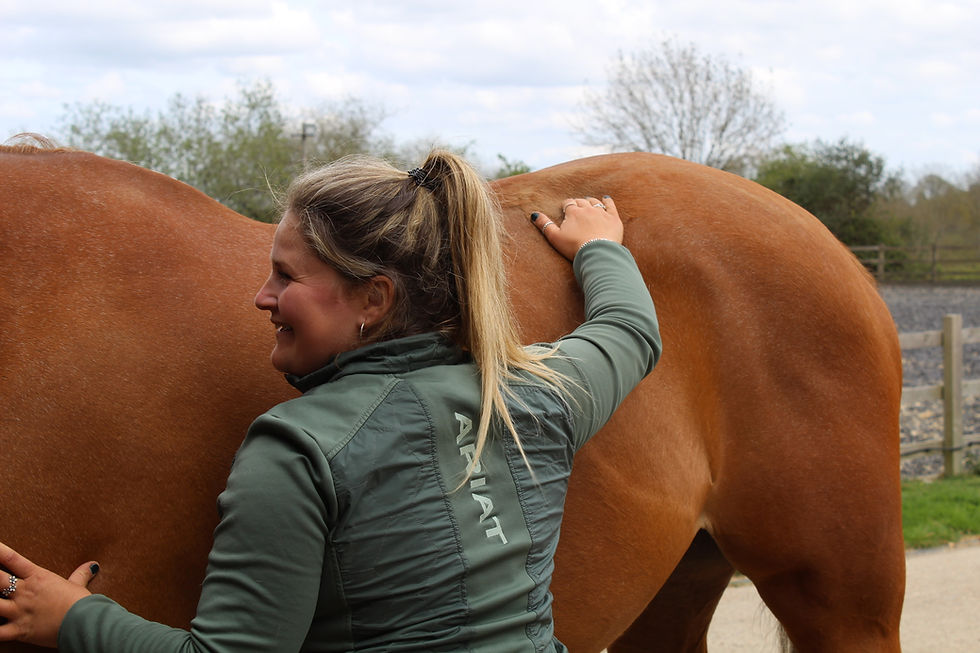How Rider Posture Affects Your Horse’s Performance
- Aiyana Everest

- Jul 25
- 3 min read
Your horse isn't just influenced by how you ride - they are also massively influenced by how you sit in the saddle and carry yourself.
As riders, we often focus on what the horse is doing: Are they straight? Forward? Soft in the contact? But here’s the truth: your horse is constantly reacting to the signals your body is giving, whether you realise it or not.
One of the most powerful (and overlooked) factors in your horse’s performance is your own posture in the saddle.
Posture = Communication
Your seat, shoulders, hips, and even head position all play a role in the subtle dialogue happening between you and your horse. Every shift in your weight or alignment sends a message. That message can be clear and helpful, OR confusing and conflicting.
When your posture is balanced and symmetrical, your aids are cleaner, your energy flows more consistently, and your horse can move more freely beneath you.
When your posture is crooked, collapsed, or tense, it creates blocks in their movement. This often leads to resistance, imbalance, or even injury.

Common Rider Posture Patterns That Affect the Horse
Collapsing to One Side
→ This puts uneven pressure through the saddle, encouraging the horse to drift, become crooked, or overload one shoulder or hind leg.
Tipping Forward
→ Often seen in riders who grip with their knees or ride with tension. This can hollow the horse’s back and restrict their hind end.
Behind the Movement (Leaning Back or Bracing)
→ Reduces the horse’s forward intention and can lead to shortened strides and tension.
Rounded Shoulders / Weak Core
→ Limits your ability to follow the horse’s movement and can block energy through the front end.
Stiff Hips or Locked Pelvis
→ Prevents proper shock absorption and can interrupt rhythm and connection; especially in sitting trot and canter.
The Horse Mirrors You
Here’s something I often tell clients: Your horse doesn’t lie.
If they’re crooked, short-striding, leaning, resisting, or constantly on the forehand - there’s a good chance your body is playing a part in that story.
Many postural habits are unconscious and deeply ingrained. That’s why rider biomechanics coaching and off-horse awareness can be game-changers; not just for your position, but for your horse’s long-term soundness and success.
How to Improve Your Posture (and Your Horse’s Performance)
Start with Body Awareness: Do you know which side you collapse toward? Do your stirrups always feel uneven? Noticing your patterns is step one.
Work Off the Horse: Rider-specific exercises for core control, hip mobility, and posture can drastically improve how you sit—and how your horse moves.
Use Mirrors or Video: A simple phone video can reveal a lot. Better yet, get a professional eye on you: what feels straight often isn’t!
Invest in a Rider Assessment: A tailored biomechanics session can identify imbalances and give you corrective strategies that are specific to you.
Final Thoughts
Your posture is more than just how you “look” in the saddle; it is how you influence your horse. Improving your posture improves your communication, balance, and harmony with your horse.
And the best part? You don’t need to be a Grand Prix rider to benefit. Every small improvement in your posture leads to a big difference in your horse’s comfort, confidence, and performance.

Ready to improve your seat and support your horse?
Let’s work together - on or off the horse - to help you ride stronger, straighter, and with more connection than ever.
Book a biomechanics coaching session or ask biomechanics coaching today!



Comments